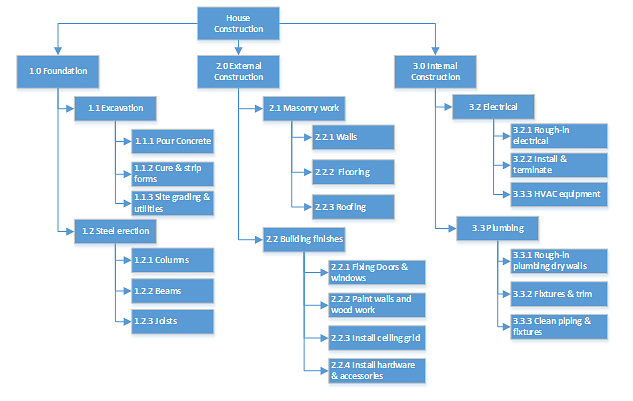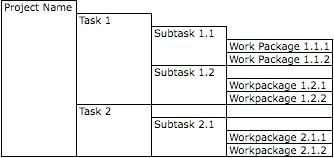Effective project management requires careful planning and scheduling to ensure that tasks and projects are finished on time, on budget, and to the desired quality.
A well-crafted project schedule is crucial for project managers to organise tasks, allocate resources, and track progress. It helps to ensure the timely completion of project tasks and identify potential risks and issues early on in the project timeline.
This article will discuss practical steps to help you create and manage project schedules effectively. By following these steps, you can develop a project schedule that is realistic, achievable, and allows for effective project management.
Steps to Developing a Project Schedule
- Step 1: Create a work breakdown structure
- Step 2: Estimate durations
- Step 3: Determine resources
- Step 4: Identify predecessors
- Step 5: Determine milestones
- Step 6: Identify dependencies
Step 1: Create a Work Breakdown Structure (WBS)
A Work Breakdown Structure (WBS) is used for estimating the project scope by breaking it down into easily manageable components, or bites. WBS is the hierarchical list of project’s phases, tasks, and milestones.
A WBS is very useful in planning a project and makes a complex project more manageable. The WBS is designed to help break down a project into manageable chunks that can be effectively estimated, managed, and supervised.
A WBS also provides the basis for a detailed duration and cost estimates. It gives accuracy in estimating a project by calculating how much time and effort is required to accomplish a task or activity, thereby aggregating to estimate the effort required to complete a superior component in the hierarchy.
Estimation Techniques
Following estimation techniques are commonly used in estimating a project scope:-
Top-Down Estimating
This technique is very useful in estimating the project when only high-level requirements are known in a project and it is then decomposed progressively into smaller activities and work-packets. For example, activity excavation is broken top-down into activities ‘Pouring concrete’ and ‘Cure and strips formation’.
Bottom-Up Estimating
This technique is used when requirements are known at a discrete level where the smaller workpieces are then aggregated to estimate the entire project. This is usually used when the information is only known in smaller pieces. For example, lower-level activities as building ‘Walls’, ‘Flooring’, ‘Roofing’, ‘Doors & windows’ may be individually estimated to arrive at duration required to complete ‘External Construction’.
WBS for a House Construction Project
The project is broken down into activities which are further decomposed into sub-tasks or sub-activities. The tasks done to complete the project are called activities. An activity is the lowest level subset in the project phase that is executed to accomplish a component of the project. Following is a WBS example for the construction of a House:

Define Broader Activities in the Project
Begin by listing the high-level activities (called summary tasks) required to do the project. Start mapping the lower-level pieces or activities in the hierarchy to the summary tasks. The high-level activities (summary tasks) to construct a house are:
- Foundation
- External Construction
- Internal Construction
Define Detail Activities in the Project
The project is broken down into lower-level activities, subtasks, and work packages until we arrive at a sufficient level of detail that supports the project plan.

Step 2: Estimate Task Duration
Once the list of activities is identified, estimate the task duration for all activities as to how much effort by duration is required to perform each activity. To estimate the task duration, make sure the activity is detailed enough to estimate how much effort each activity or sub-activity will require to complete.
For example, to calculate how much time is required to complete the ‘Excavation’ for constructing the house, you may need to know what is involved in doing excavation and how much time is required to complete each activity in the excavation. List the set of activities required to do excavation on the site and estimate the duration of each activity.
Step 3: Determine the Resources Requirements
Determine the personnel and non-personnel resources required to perform all activities. For example, the excavation work may require the following resources: Project Manager – Work duration 16 hours Site Grading Contractor – Work duration 80 hours.
- Create a Resource Table of all resources who will work on the project
- Assign or Allocate resources to activities
Step 4: Identify the Dependencies Between Tasks
After identifying all the activities and timeline necessary to complete the project, we identify and define the immediate predecessors of all activities. This will determine the sequence in which the activities may be performed. For example, excavation work will be carried out before the steel erection can be done. Hence, the predecessor to ‘1.2 Steel erection’ activity will be ‘1.1 Excavation’.
Step 5: Identify Dependencies
In a project, dependency is a link between tasks or activities or elements. There are four kinds of dependencies:-
Finish to Start (FS): A FS B = B can't start before A is finished or B will start only after A is finished.
For example, concrete must cure before it can be used. Therefore, the builder pours the concrete, waits four days and then builds the walls on the concrete.
Finish to Finish (FF): A FF B = B can't finish before A is finished, i.e., B will finish only after A is finished.
For example, Foundations excavation cannot be completed unless the elevator pit excavation is complete.
Start to Start (SS): A SS B = B can't start before A starts, i.e., B can start only if A has started.
For Example
- Curing cannot be started unless pouring for the foundation has started. Start to Finish (SF): A SF B = B can't finish before A starts, i.e., B can finish only after A has started.
- Pouring & curing is a parallel activity and Pouring can finish only after curing has started.
During the project planning phase, the project is estimated to list out the set of activities, tasks, and resources required to complete the project. The project schedule is detailed enough to show each task to be performed, the resource allocated to perform the task, the start and end date of each task and the duration in which the task will be performed. During the lifecycle of a project, the project progress is monitored by the project schedule.
Step 6: Determine Milestones
The project is broken down into discrete chunks and the related tasks are grouped together as a phase or component. This phase or component of the project is assigned a measurable milestone as the target date or time to finish it. For example, based on the estimation of the whole project, it is broken into phases with milestones as below:
Milestones are significant events that are either reached or imposed upon the project on completion of a phase. A milestone signifies the completion of a major phase in the project.
Learn from experts who help you pass the examination post enrolling in Simplilearn's PMP training course. Sign-up today for PMP® Certification Training Course!
Explore our PMP® Certification Training, and get the chance to attend live online interactive classes, Harvard Business Publishing case studies, and capstone projects. What are you waiting for? Your successful project management career is a click away. Enroll today!

